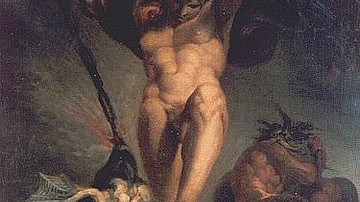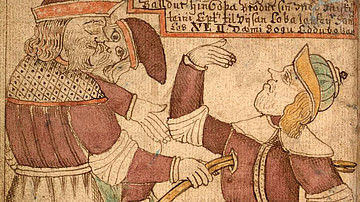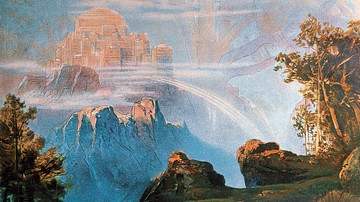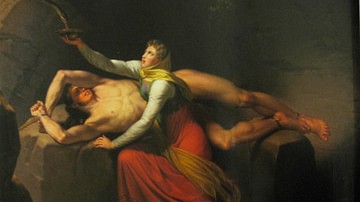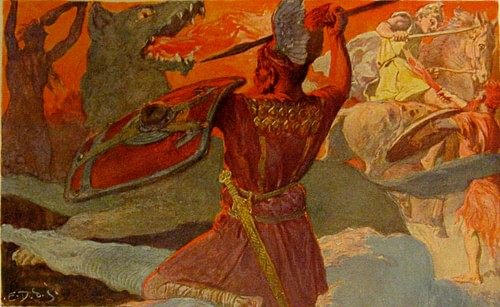
Odin (Old Norse: Óðinn) is the main god in Norse mythology. Described as an immensely wise, one-eyed old man, Odin has by far the most varied characteristics of any of the gods and is not only the deity to call upon when war was being prepared but is also the god of poetry, of the dead, of runes, and of magic.
He also exists in Germanic mythology as Woden (in Old English), Wodan (in Old Franconian), and Wutan or Wuotan (in Old High German). The modern English weekday name Wednesday traces its origins to "day of Woden", wōdnesdæg in Old English, and is still seen in the Dutch name woensdag.
Part of the Æsir family of the gods, he helped create the world, resides in Asgard (the stronghold and home of the gods), and gathers slain warriors around him in Valhalla ('hall of the slain'), but is eventually crunched to death by the wolf Fenrir in the Ragnarök, the 'final destiny of the gods' in which the world is destroyed.
Functions
Odin is an old, original character in Norse mythology although, as Jens Peter Schjødt points out, many scholars think that his elevated position at the top of the godly hierarchy may be a later addition (219). Odin's role of 'Allfather' or father of the gods is more of a literary theme from later sources - seemingly influenced by Christian names for God - than an actual reflection of his status in Viking Age societies. Skaldic poetry (Viking Age, pre-Christian poetry mainly heard at courts by kings and their retinues), for instance, names Baldr, Thor, and Vali as Odin's sons, whereas later on the 13th-century CE Icelandic author Snorri Sturluson also adds Heimdall, Týr, Bragi, Vidarr, and Hodr to the list. Incidentally, despite him being married to Frigg a lot of these sons are from different mothers and Odin appears in many stories as a womaniser, even boasting of his affairs, reminiscent of (and perhaps inspired by?) Zeus from Greek mythology.
More tangible is Odin's function as the god of war. Despite his grizzly look he was never actually depicted as a warrior (that, rather, was Thor's gig) but was called upon when war was being prepared to hand out advice and special gifts. In southern and western Germanic sources, it was Odin who decided whether battles or individual warriors would be victorious or end in slightly less fortunate ways. Odin has his Valkyries - supernatural warrior women - bringing the bodies of fighters slain in battle to his special warrior paradise Valhalla; these fighters are known as the Einherjar and become Odin's strike-force against the encroaching powers of the Underworld during the Ragnarök. Because of this aspect, individual warriors are also drawn into Odin's main group of worshippers, which otherwise mostly consisted of the elite: kings, chieftains, and poets.
As his scavenging the battlefields for recruits might give it away, Odin's connection with war flows naturally into a connection with the dead, which is further illustrated by Odin as the leader of the so-called Wild Hunt – a widespread and old Germanic cult centred around a myth of an army of the dead who ride on the storms. He is also the god of poetry through his knowledge of the runes, as well as of magic (seiðr), even being deemed the most skilled and knowledgeable of all the gods when it comes to this skill. Odin used mainly magic to catch glimpses of the future. As Neil Price explains:
He [Odin] is described as falling into trances, as leaving his body behind and travelling abroad in the spirit-form of an animal, and several times as having visions of wisdom provoked by various kinds of ordeal. (246)
This kind of divination ties in very well with Odin's role as advisor and would have been of much interest to Viking Age rulers. The nature of Odin's magic moreover often causes him to be seen as a shaman, an aspect which is further bolstered by his function as a god of healing.
Attributes
Odin can be recognised by his hat and cloak, long beard, and only one eye (reminding somewhat of Gandalf from Tolkien's The Lord of the Rings bar this last aspect). His spear Gungnir is one of his main attributes and seems to have been present in Viking Age belief, as hinted at by miniature spearheads found throughout south and central Sweden.
Some other attributes are the ring Draupnir, which drips to form eight new rings every nine nights, and the horse Sleipnir, which is mentioned early on in Old Norse literature and is set apart by the somehow efficient total of eight legs. Likewise, Odin's two ravens, Huginn ('thought') and Muninn ('wisdom') are very old mythical elements already well-established – proven by their appearance on ornaments and rune stones - before c. 800 CE. They fly around the world gathering news, and when they return, they sit on Odin's shoulder and whisper their tidings into his ear. The Prose Edda has Odin say:
Huginn and Muninn hover each day
The wide earth over;
I fear for Huginn lest he fare not back, -
Yet watch I more for Muninn.
(Gylfaginning, 38)
Due to this Odin is also known as 'the raven-god'. If you have ever seen a (movie version of a) battlefield after the action has died down, it becomes clear how Odin's ravens tie in with his role as god of war and connection with the dead; a battlefield is not just a feast for crows but also a feast for ravens.
Other attributes are the Valkyries - who are likely represented by small, female figurines sometimes holding a drinking horn, indicating worship of Odin - and his wolves Geri and Freki. He might also be linked with the eagle and the snake, and his potential function as shaman means the staff is highlighted, too.
Myths Involving Odin
In line with how shaky our knowledge of Norse mythology as it was in the Viking Age really is, our limited source material only has three gods headlining in more than one known myth; Odin is one of them, alongside Thor and Loki. Most likely, we only have the skeleton of the stories the Vikings in the pre-Christian period would have told and believed about these gods. Some of these bones are as follows:
Before the creation of the world, Búri, the forefather of the gods, appeared out of the ice, and his son Borr and the giant-daughter Bestla sired Odin and his brothers (usually named Vili and Vé). The brothers then slew the proto-giant Ymir and used his flesh to create the earth, his skull to form the sky, his bones for the mountains, and his blood to make the sea. With an actual residence in place, they then shaped the first human couple, Ask and Embla, out of two trees or pieces of wood.
Odin's immense knowledge is courtesy of Mímir's head (or else due to drinking from Mímir's well). Mímir was a wise advisor about whom Snorri Sturluson reports how the Vanir (the family of fertility gods) chopped off his head and sent it to Odin, who turns to magic and healing herbs to keep the head from decaying so it can forward secret clues from the 'Other World'. According to Snorri, the price Odin has to pay for this is one of his eyes. His boosted knowledge pops up in a few other myths (known from the Poetic Edda); in the Vafþrúðnismál Odin initiates a battle of wits with the giant Vafþrúðnir and beats him, while in the Grímnismál a disguised Odin is tortured and ends up revealing his extensive mythical knowledge to King Geirroðr.
Furthermore, Snorri explains that Odin's superb poetic skills are due to him stealing the mead of the skalds (i.e. poets) by sleeping with the giantess Gunnlǫð, guardian of the mead, for three nights. Because of this cosying up to her, he is allowed three sips, but he simply chugs and drains the containers, shape-shifts into an eagle and legs it (well, wings it) out of there. Also connected to poetry, Odin gains knowledge of the runes, too, attributed by the Hávamál poem to a self-sacrifice:
I know that I hung on a windy tree
nine long nights,
wounded with a spear, dedicated to Odin,
myself to myself,
on that tree of which no man knows from where its roots run.
(Hávamál, 138)
His relentless pursuit of knowledge is made clear here in the lengths the benevolent king of Asgard goes to (very deliberately – he sacrifices himself to himself) in order to unlock the runes; nine nights of swinging from a branch of Yggdrasil, the World Tree, with a spear wound that put him close to death, and only then are the runes revealed to him.

At the Ragnarök, Odin's wisdom and power are put to the test. Natural catastrophes including a horrible winter, as well as Fenrir devouring the sun, herald the coming of the forces of the Underworld, Heimdall sounds the alarm, Mímir's head is consulted, and the gods have a huddle underneath Yggdrasil to decide what to do. However well-prepared, though, once the battle erupts Odin bravely takes on Fenrir but meets his end in the creature's jaws, dying alongside many of his fellow gods who perish to various foes but also slay many in the process.
Cult of Odin
Belief in Odin was so widespread throughout Germanic regions in the pre-Christian period and parallels between him and the Indian god Varuna so unmistakable that it is likely his origins lie all the way back in the earliest times of Indo-Germanic tradition. Already in the Bronze Age do Swedish rock carvings depict figures of a god holding a spear, who with some imagination might be linked to Odin, and by at least 500 CE he clearly shows up on a range of ornaments alongside birds and warriors. Viking Age picture stones carry on this trend and depict him riding to Valhalla among other things.
However, when bearing in mind his later status as top dog in Norse mythology, actual tangible evidence of a cult of Odin is quite sparse. Places named after Odin – a decent indicator of cult practices and popularity – are entirely absent in Iceland between its settlement and the coming of Christianity, and very rare in the south of Norway, although they pop up here and there in the south of Sweden and in Denmark. Thor, in contrast, steals all the limelight and is much more visible in a cult context than his father. Luckily, Rudolf Simek has a way to soothe our confusion:
Indeed, it seems likely that the literary sources considered him to have such an elevated position from their own point of view, since there can be no doubt that Odin was the god of poetry (and poets), and our sources, which come either directly or indirectly – via Snorri's systemization – from the skalds of heathen times not surprisingly show a particular inclination in favour of the god of their own craft. (243)
So, rather than there being an all-encompassing cult of Odin as the benevolent king of Asgard in Norse and Germanic mythology, it makes more sense that he was venerated in specific contexts and by specific individuals – mostly poets, warriors, chieftains, and kings. Grisly human sacrifices, for instance, tend to be exclusively dedicated to Odin. Otherwise, in Viking Age belief, he was just one of the gang. This is visually spelled out in the great pagan temple of Old Uppsala in Sweden, too; in 1070 CE Adam of Bremen wrote of his visit to this place that a statue of Thor stood prominently in the centre of the hall, with Odin and Freyr to the side, and that sacrifices were made to Thor in case of famine, to Odin in times of war, and to Freyr for wedding-related activities.



